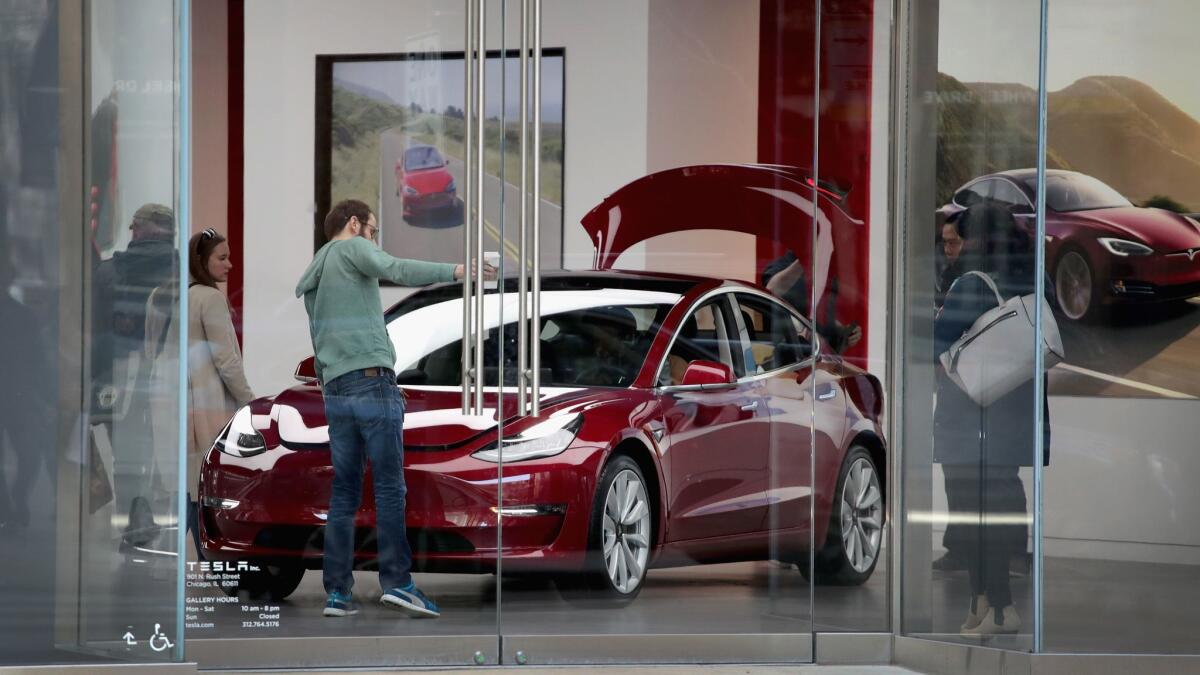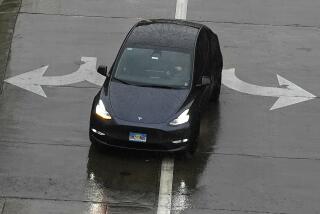Tesla says Model 3 production nearly tripled last quarter, but it still disappointed

Last month, Tesla Inc. cobbled together an additional production line in a tent on the grounds of its Fremont, Calif., factory to try to boost production of the company’s Model 3 electric sedans.
It worked. Last week, the Palo Alto electric car maker finally hit its production goal of assembling 5,000 Model 3 cars in a week. And on Monday, Tesla said it produced 28,578 Model 3 vehicles in the second quarter — almost three times as many as it made the previous quarter — and delivered 18,440 Model 3s.
But the “incredible job” that Tesla Chief Executive Elon Musk credited to his workers in an email Sunday, and the “entirely new solutions” they employed to reach the goal, left many industry analysts wondering about the sustainability of the production push.
It also wasn’t enough to match most analysts’ expectations. On average, eight analysts estimated that Tesla would deliver about 26,121 Model 3s, according to Bloomberg. (Tesla said that about 11,000 Model 3 vehicles were “in transit” to customers at the end of last quarter and are expected to be delivered early this quarter.)
Investor skepticism drove shares of Tesla down $7.88, or 2.3%, to $335.07.
Adam Jonas, equity analyst at Morgan Stanley, said in a note to clients Monday that news that Tesla met its weekly production goal “should not come as a complete shock to investors given the extraordinary short-term efforts of the firm.” He specifically noted the assembly line in the tent, which Tesla credited with producing about 20% of the Model 3s made last week. Musk said in April that the company would hire about 400 people a week for several weeks to help with production, according to an email obtained by Electrek.
The company said Monday that the vehicle quality was “as good as” that of vehicles coming off its other assembly lines.
But Jonas said there was a “big difference” between making 5,000 Model 3 vehicles in one week and sustaining that level of production every week.
“I’m not saying it’s impossible for Tesla to hit 5,000-plus cars a week in production at some point,” said Karl Brauer, executive publisher at Kelley Blue Book. “But it’s taken a lot longer than it was supposed to.”
Also on Monday, Tesla said its senior vice president of engineering, Doug Field, left the company June 27 after almost five years. Field had pushed Tesla employees to reach quarterly Model 3 production goals, telling staff to “prove a bunch of haters wrong” in a March email obtained by Bloomberg.
But by April, Musk had taken control of manufacturing, and one month later Tesla said Field was on leave to spend time with his family, according to Bloomberg.
Tesla has been under pressure to ramp up its production of the Model 3, the vehicle that is supposed to turn the company into a purveyor of affordable electric cars to the masses. But it has missed targets time and again. The company has never earned an annual profit.
Tesla said it made more Model 3 cars last quarter than Model S sedans and Model X SUVs combined — the first time it has done so. The 53,339 total vehicles it produced last quarter was a 55% increase from the previous quarter, Tesla said; it delivered 40,740 vehicles. The company called it the “most productive quarter in Tesla history by far.”
Colin Rusch, an analyst at Oppenheimer, described the delivery and production numbers as “modestly better than feared.”
He said in a note to clients that he believed it “plausible” that Tesla could soon churn out 5,000 Model 3 cars a week on a single assembly line, as the company said Monday, but he said the automaker probably has to do “significant work” before that can happen.
Tesla also has not defined what it means by vehicles “produced.” For other automakers, “produced” means the moment a car exits the production line fully finished.
But Musk used an unusual phrase in describing production numbers in a memo to employees: “Not only did we factory gate 5,000 Model 3’s, but we also achieved the S & X production target for a combined 7,000 vehicle week!”
The Times asked Tesla on Sunday what Musk meant by “factory gate.” The company did not respond. Anton Wahlman, a short seller betting that Tesla stock will drop, wondered whether there is rework to be done on “factory gate” Model 3s.
The company said Monday that the number of unfulfilled Model 3 vehicle reservations at the end of last quarter remained about 420,000, even though production has increased and Tesla already has delivered 28,386 of the cars.
“When we start to provide customers an opportunity to see and test drive the car at their local store,” the automaker said, “we expect that our orders will grow faster than our production rate.”
Tesla said Monday that it expects to increase production of its Model 3 vehicles to 6,000 cars a week by late next month. The company is still aiming to deliver a total of 100,000 Model S and Model X vehicles in 2018.
Kelley Blue Book’s Brauer said Tesla needs to show this quarter that it can consistently make at least 5,000 Model 3 cars a week, especially to start chipping away at the mountain of reservations.
“There’s a lot to be done … to come close to making headway against this backlog, and to convince the average analyst and maybe consumer that Tesla can deliver on high-volume vehicle production,” he said. “Producing cars at a high volume is totally different than making a niche product.”
As Tesla ramps up production, it is speeding toward a complication: Once an automaker sells 200,000 electric vehicles in the United States, a $7,500 federal tax credit for buyers of that company’s electric vehicles begins to phase out.
Tesla does not break out its vehicle sales figures by geography but it is expected to hit that 200,000 point soon. When it does, buying a Tesla vehicle in the U.S. will become, in effect, more expensive, giving an edge to Tesla’s competitors.
Times staff writer Russ Mitchell in San Francisco contributed to this report.
Twitter: @smasunaga
UPDATES:
3:20 p.m.: This article was updated throughout.
11:30 a.m.: This article was updated with Tesla’s stock movement and with details from Morgan Stanley and Oppenheimer analysts’ notes.
10:35 a.m.: This article was updated with Tesla’s stock movement and with comment from Kelley Blue Book’s Karl Brauer.
8:50 a.m.: This article was updated to include details about production targets and federal tax credits, as well as a comment about the term “factory gate.”
7:15 a.m.: This article was updated to include details about production on the new assembly line, analyst estimates and unfilled vehicle reservations.
This article was originally published at 6:50 a.m.
More to Read
Inside the business of entertainment
The Wide Shot brings you news, analysis and insights on everything from streaming wars to production — and what it all means for the future.
You may occasionally receive promotional content from the Los Angeles Times.










